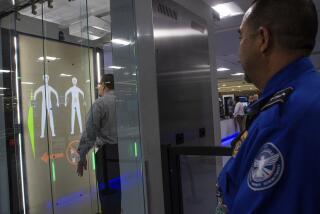No stripping, no pat-downs: Could this be the airport checkpoint of the future?
- Share via
“Passengers should be able to get from curb to boarding gate with dignity. That means without stopping, stripping or unpacking, and certainly not groping.”
With that declaration, Giovanni Bisignani, director general of the International Air Transport Assn., unveiled a mock-up of an airport “Checkpoint of the Future” Tuesday at the annual meeting of the worldwide airline organization in Singapore.
The sleek, high-tech mock-up, in the works for more than a year, builds on the concept of airport screening that focuses on higher-risk passengers -- a vision recently endorsed also by the U.S. Transportation Security Administration and the U.S. Travel Assn.
The IATA proposal would funnel fliers through one of three checkpoint lanes based on their perceived security risk. Many fliers might be able to walk quickly through a tunnel while being automatically screened for explosives, metal and other threats. They would not need to remove clothing or unpack their bags for inspection.
The three lanes would be “known traveler,” “normal” and “enhanced” security. Travelers, after presenting a passport or other document with a “biometric identifier,” would be assigned to a lane based on “a risk assessment conducted by the government before the passenger arrives at the airport,” an IATA news release said.
To access the fastest lane, “known traveler,” you would have to register and submit to a government background check. You would probably also pay a fee to participate, Kenneth Dunlap, IATA’s global director of security and travel facilitation, said in a recent interview.
If this sounds like the Registered Traveler program, which the TSA tested and abandoned a few years back, you’re not far off. In that program, travelers were typically charged around $100 to undergo a background check and get access to shorter checkpoint lines, where they underwent basically the same screening as other passengers.
But in a recent interview, Dunlap said that under the IATA proposal, vetted travelers would be screened differently than others. For instance, although screened for explosives and metal, they might not have to remove coats or belts. He said he figured about 30% of fliers might opt for this “known traveler” process.
A much smaller number of travelers might be assigned to the “enhanced” lane, where they would receive a secondary screening. These would be people viewed as higher risk based on computerized background checks or suspicious behaviors, he said. Some people might also be randomly assigned to that lane.
Most travelers, Dunlap said, would go to the “normal” lane. They would move faster, in part, because more than 30% of travelers would be assigned to other lanes.
Don’t expect the new checkpoint system to pop up any time soon. It would require significant design changes, and the technology for fully automated screening is not there yet.
But in a news release, IATA’s Bisignani said: “We have the ability to move to the biometric scanning and three-lane concept right now. And while some of the technology still needs to be developed ... we could see major changes in two or three years’ time.”
More to Read
Sign up for The Wild
We’ll help you find the best places to hike, bike and run, as well as the perfect silent spots for meditation and yoga.
You may occasionally receive promotional content from the Los Angeles Times.






